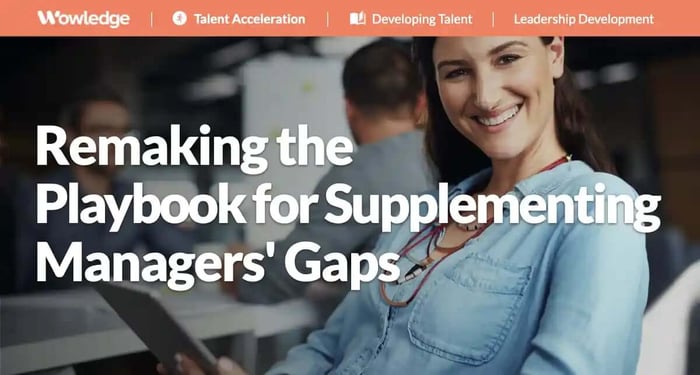Table of Contents
- The work (and burdens) of a middle manager
- The price being paid
- Solutions to support middle managers: new as well as trusted
- 1. Identify the highest priority tasks
- 2. Select candidates with the necessary skills and capabilities
- 3. Listen to the managers
- 4. Increase managerial discretion
- 5. Share responsibilities as a group
- 6. Communicate and reinforce leadership values
- 7. Hold managers accountable
- 8. Eliminate and/or shorten meetings
- 9. Reduce handoffs of administrative duties
- 10. Provide job aids
- 11. Offer training and development options that meet their needs
- An important development opportunity for the middle management role
- Relevant Practices & Tools
- FAQs
-
Middle Management is a curious invention of the 20th-century corporate world. Curious in that individuals in those roles are expected to simultaneously be able to think, analyze, plan, and act at both the strategic and operational levels. They need to be, at various times, coaches, financial experts, technical gurus, communicators, talent managers, and performance drivers. They are often called upon to manage or oversee large-scale projects in addition to their normal duties and responsibilities.
They report to top leadership and manage managers, supervisors, and/or individual contributors. They are asked to translate, communicate and ensure the implementation of company objectives, initiatives, policies, and directives. They neither set strategy nor directly oversee the execution, and as a result, need to rely upon the wisdom of their superiors and the focus and tenacity of their subordinates.
They are stuck in the middle, between acting as a deferential and humble subordinate to top leadership while demonstrating confidence and control to those who report up to them. They conduct the work that goes on between the policymakers at the top and the target populations acting in concert with those below.
The work (and burdens) of a middle manager
The role of middle management is to translate those strategies and policies into digestible and actionable directions for the employees who are asked to both contribute and comply. As managers-of-managers, they make sure that the efforts of their teams are in line with the vision of top leadership while understanding, addressing, and removing the roadblocks that those teams face.
And while they’re at it, they still need to conduct daily tasks that enable the meeting of corporate objectives and initiatives, including:
• Defining and approving staffing requirements
• Managing contractors and contracts
• Hiring and onboarding new employees
• Setting and distributing individual and team goals and workloads
• Managing performance, discipline and terminations
• Submitting and managing budgets
• Communicating direction, progress, results, policies, practices and procedures
• Overseeing and refining work processes
• Coaching, mentoring and providing performance feedback
• Managing strategic or improvement projects
• Acting as a subject matter expert in a functional or technical area
• Managing conflict
• Creating and sustaining networks – internal and external
Needless to say, middle management offers a unique perspective on most of the employee productivity and organizational performance barriers and challenges that an organization faces—with ears necessarily open to both top leadership and line employees. But it tends to be a heavy burden and comes with a price.
The price being paid
It is no surprise then to see the research telling us that more than any other group or level of employees, middle management experiences higher levels of depression, anxiety, stress, burnout, low satisfaction, hypertension and even heart disease. Adding the recent impacts of flattening of organizational structures, the pandemic, supply chain issues, and generally poor economic trends on top of the ages-old plight of the middle manager, they are feeling the heat more than ever before.
They also led the great resignation, with more in the middle management ranks having left and nearly 50% more reported plans to leave their employers in the following year, according to reports from Fortune. Combined with the technology sector’s recent organizational delayering and downsizing of thousands of middle managers, the role is clearly under siege, with those who remain looking towards a future of higher manager-to-employee ratios and workloads.

Solutions to support middle managers: new as well as trusted
Workplaces and workforces are changing right in front of us, and the old solutions and preferences are no longer addressing the problems at hand. Telling employees that they must come back to work four days per week and expecting compliance is an old solution to the new problem of “I’ve already been working productively without commuting”.
It is both the burden and blessing of the middle manager to be amid the changes and the need for solutions. The burden is that they operate under powerful leaders and thus need to try to drive change from the middle upwards by offering new solutions. The blessing is that they are in the best position to understand the tension between corporate needs and those of the workforce.
It’s time to better leverage their position while unburdening them of some of the administration of people, process, and program management. The solutions should be integrated into a package whose elements work together to change the experience of the middle manager while addressing the realities of today’s corporate and business environments. A sampling of the elements for such a solution set includes:
1. Identify the highest priority tasks
Review job analyses and descriptions to identify what activities add the greatest value to the achievement of both business and talent goals. Assess which leadership competencies are most critical to successful management at each level of the organization. Particularly after an organizational “flattening” or Reductions in Force (RIF) of managers, this exercise should be conducted to help provide guidance to role-holders about how to best spend their time and resources.
The tasks selected should be assessed against the backdrop of recent and projected talent and business trends—much like when sales goals are increased during times of softened results. In any of these cases, provide guidance as to the prioritization of such tasking—to guide managers when they are balancing competing necessities. And further consider whether some of the lower-level tasks or responsibilities can be pushed down a level further to line managers or employees (or eliminated altogether).
2. Select candidates with the necessary skills and capabilities
Managers have a whole host of duties and responsibilities that require wide and varied knowledge, skills, and abilities—from numerical to interpersonal to analytical, from strategic to operational. Careful selection of individuals with the right mix of technical, interaction, planning and political skills is essential and one key element of reducing managerial burnout and turnover. Leading organizations use formal and validated assessments to project each candidate’s future level of success in the role and use those to identify the development-related shortcomings of those selected. Motivation to perform the job is not enough, especially given the unprecedented challenges that middle managers are facing today.
3. Listen to the managers
Leverage regular (e.g., annual) surveys, focus groups or listening sessions with middle managers and ask them what gets in the way of their productivity. Through this, insights into common concerns about certain processes or practices (e.g., performance management, subcontract RFP standards, etc.) can yield opportunities to reduce steps or simplify requirements for faster and/or more effective administrative processing. Further leveraging of such listening capabilities can be used to raise upper management’s awareness of systemic issues and potential solutions that can both ease the middle manager’s workloads and concerns while addressing drags on employee productivity and effectiveness.
4. Increase managerial discretion
Conduct a review of existing policies and procedures to look for opportunities where managers can act without requesting input or consent (e.g., spending approvals needed above a certain threshold). Understanding where micromanagement is occurring is an important step in relieving bureaucracy that plagues many in middle management.
5. Share responsibilities as a group
Certain practices can be made more effective by engaging a group of managers to relieve individuals of the weight of responsibility to “get it right” on their own when making certain types of decisions. A prime example is the use of talent review processes, where managers get together and share feedback and data on each employee within a common grouping and determine relative performance levels/ratings, salary increases, bonus payouts, potential ratings, development options, and next roles, etc. Other examples include the use of managerial team meetings to provide input to corporate strategies, cascade and assign functional/departmental goals, create operating budget requests and distribution decisions, etc.
6. Communicate and reinforce leadership values
Provide structure, reminders, and role modeling of expectations of preferred managerial behaviors and standards for reinforcement of what is most important in their roles. Managers need to know and be reminded of what is expected of them to generate consistent and reliable behavior on their part. The use of a leadership competency model in managerial training, performance evaluations, and in succession/career discussions further bolsters the certainty.
7. Hold managers accountable
Provide performance and development feedback using objective measures of their success on the most important tasks and behaviors identified above. Leverage regular and/or pulse employee engagement or experience surveys, skip-level sensing sessions, and reporting on hiring, turnover, reason for leaving, transfers in and out, budget performance, and project schedule adherence to assess managerial success. Making such data the core of their regular assessment and coaching drives home the importance of managing people relative to other indices of department or function output, including those related to tasks, processes, projects, finances, and others.
8. Eliminate and/or shorten meetings
Limit the regular update meetings and reports that middle managers are required to prepare for and attend, by instead relying on regular and brief “high point” meetings, where the manager shares only the top three issues and accomplishments with his/her leader. Further consider whether the updates are opportunities for micromanagement, and ways that can be avoided.
Also, consider the use of regular “stand-up” leadership team meetings (in place of traditional staff meetings) where each manager has 3-5 minutes to share information that specifically concerns information needed for collaboration and coordination with peer managers. Individual follow-up meetings can be created when issues require more than one manager to coordinate action. These can help reduce both unnecessary sharing and oversharing of accomplishments with peers.
9. Reduce handoffs of administrative duties
Reconsider the administrative workflows that managers handle that can be automated or handled by support organizations. When attempting to operate a lean support organization (Finance, HR, Procurement, Security) work has been historically shifted to managers under the heading of “self-service”. The resulting issue is that the administrative work burden has increased on middle managers. Consider the adoption of AI agents and technologies such as “bots” and APIs that can perform the repetitive aspects of administrative tasks in middle management. Examples of applications include the completion of fields in forms (e.g., employee core data into performance evaluations, transfer forms, job applicant responses), automatically populated FAQs, embedded job aids (e.g., preparing for an employee coaching session), etc. Alternatively, change the resume review process to include automatic presentation of only the 10 top candidates to the hiring manager, or automated presentation of development activities that are matched to each employee’s unique performance deficits or career aspirations, etc.
10. Provide job aids
Help managers better communicate policy, practice, or program information with a standardized managerial knowledge portal that includes communication plans, tools (e.g., PowerPoint decks, email text, FAQs). Embed guidance on existing or new processes into the talent management or HR information system, such that the guidance is available at their fingertips while they are performing the task. Provide both mobile and desktop apps that have quick use guides to support common communications activities, such as performance check-in sessions (questions to ask, questions the employee will be similarly guided to ask), disciplinary action meetings, interview questions, vendor selection guidelines and questions, etc.
11. Offer training and development options that meet their needs
Reduce the need for long-drawn-out managerial training programs by limiting the number of formal learning sessions. Create a continuous learning and development environment that is best suited to the time and task demands that middle managers face. Consider offering a “signature” course attended by newly promoted or hired managers that covers the major topics related to their primary tasks and responsibilities, the managerial culture to which the company aspires, providing exposure to top leaders, and activities and exercises that help participants start to build a support and collaboration network.
Augment that classroom experience with such activities as individual onboarding coaching and assignment of a formal mentor on the senior leadership team. Further the ongoing nature of development that leverages the criticality of peer relationships and strategic thinking/action through the offering of group coaching engagements, mastermind groups and strategic action learning projects. By having them learn and develop with their peers, all managers will have access to insights and people who are supportive of their journey as a leader.

An important development opportunity for the middle management role
As we’ve seen, middle management is a tough job to fill while maintaining one’s engagement and motivation (and mental health) for a long period of time. As a result, it is incumbent upon the company to manage this situation, with logical and constructive practices that leverage the skills of carefully selected individuals while providing a needed break from the myriad of challenges that they face.
A formalized employee mobility strategy can offer relief for the organization and the managers. Formal rotations from managers to other types of roles, such as individual contributors make the most sense and can be managed in a succession management or similar process. Much like how large consulting and accounting firms guide the careers of their partners, movement between different functions and types of roles not only rounds the person out but provides relief from some of the more intensive or stressful roles.
This solution requires the creation of career paths that encourage people to move between managerial and non-managerial paths, from people management to program management, from program management to expert contributor, and then back again. For example, a pathway from Director of Systems Engineering to a Principal Investigator to a Project Manager, and then on to a Vice-President of Engineering Operations would provide both a needed break, development from three very different types of roles, and then on to a promotion for which the individual is well-prepared. Further consideration should be given to limiting the time in managerial roles to three years, with compensation and classification systems (in a job architecture) supporting such movement without loss of status, salary, or bonus.
At the end of the day, it is imperative that companies provide continuous, systemic and programmatic support to middle managers throughout their tenure for the company to maintain consistency across management and time. A mix of selection, prioritized tasking, two-way communications, streamlined administrative responsibilities, accountability measures, development, and job support mechanisms can be packaged together for a structured and constructive handling of a long-standing challenge for organizations and their leaders alike.
Relevant Practices & Tools
Core Leadership Development Practices to Define and Structure Leadership Capabilities. >
Leadership Development (LD) is the strategy and process of developing the key skills, capabilities, and styles needed by top leaders to successfully drive organizational performance... more »
Defining an Impactful Vision of the Leadership Strategy and Brand. >
A leadership strategy is a plan for how leaders will be used to drive company objectives and goals. It is essentially a vision that defines the leaders, describes their traits, how they should act... more »
Engaging External Executive Coaches and Internal Mentors to Build Leadership Capability. >
When creating a coaching and mentoring capability focused on leaders, best practices suggest starting with the use of experienced external coaches to focus the initial applications of this... more »
Defining Career Lattices to Define Robust Lateral and Vertical Mobility. >
The ability to enable the movement of employees proactively and strategically from role to role at the leadership, professional, and operational levels is a key flexibility that advanced career... more »
The Manager Coaching Feedback Survey Tool: Define and Apply Basic Questions for Employees Providing Feedback on Managers' Coaching Prowess. >
This tool functions as a guide to developing questions to assess the extent to which a line manager is providing quality coaching during regular performance check-in or formal discussions... more »
FAQs
How can organizations give middle managers more discretion without increasing risk?
Policies should define decision guardrails—financial limits, compliance boundaries, and escalation triggers—then delegate within them. Preapproved playbooks for common scenarios allow managers to act quickly while staying aligned. Post-decision reviews sample a subset of actions to reinforce learning and adjust thresholds. The result is faster execution with clear accountability.
How can companies reduce administrative load on middle managers without sacrificing control?
Standardize workflows and move rule-based steps to shared services or bots that pre-populate forms, route approvals, and surface exceptions only. Replace broad self-service with targeted “assisted service” for complex cases to avoid shadow HR and finance work. Dashboards that consolidate budget, headcount, and project signals cut status reporting time. Governance focuses leaders on thresholds and exceptions rather than routine oversight.
What development approach works better than long managerial training programs?
A compact “signature” onboarding course sets expectations and lays the foundations in the first week or month of the role, followed by ongoing micro-learning, group coaching, and action-learning tied to current priorities. Formal mentoring from senior leaders accelerates the development of political and strategic judgment. Peer forums or mastermind groups provide real-time problem-solving and reduce isolation by learning with and from others. This continuous model respects time pressure while building durable capability.
How should performance management hold middle managers accountable for people and business outcomes?
Objective metrics—hiring quality, regrettable turnover, engagement items on manager effectiveness, budget adherence, and schedule predictability—should share weight with project or production outcomes. Performance ratings should be compiled using reference evidence from pulse surveys, skip-level “sensing” sessions, goal achievement, and delivery data, rather than solely a narrative or summary from the next-level manager. Development plans should target a few behaviors with measurable checkpoints across the review cycle. Progress influences rewards and readiness for a broader scope.









